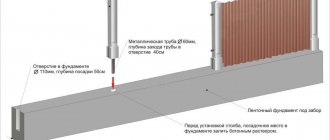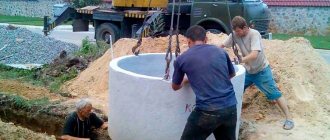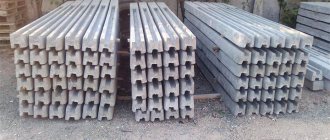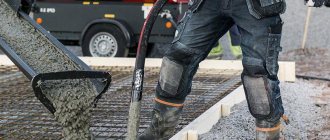Before you begin applying the finishing coat to the floor, you need to make sure that the concrete surface is sufficiently smooth. Grinding concrete with a grinder is carried out before applying impregnation, removing dust and treating with varnishes and paints. A competent approach to this operation ensures reliable adhesion of the polymer to the concrete coating. By following certain stages of work, you can use a grinder to sand the concrete.
Using a grinder, it is convenient to grind concrete surfaces in hard-to-reach places.
Advantages and applications of polished concrete floors
Treated concrete floors have gained great popularity among finishing coatings not only in the public but also in the private category. It is mainly used:
- in medical and educational institutions;
- in shopping and sports centers;
- in water parks;
- in entertainment establishments;
- at cultural venues;
- in suburban areas;
- as a floor covering in outbuildings and garages;
- Increasingly, polished concrete floors can be found in dressing rooms and corridors in the homes of ordinary citizens.
It has earned such a wide range of applications due to its performance characteristics, which in many ways exceed the advantages of even the highest quality finishing coatings:
- the service life is estimated at decades, which is ensured not only by its increased strength characteristics, but also by its resistance to moisture saturation. An ordinary concrete screed without a finishing coating or treatment does not have such significant advantages;
- the floor sanded to a gloss is similar to elite self-leveling coatings;
- affordable cost;
- is an ideal basis when a perfectly flat base for a decorative coating is required;
- does not produce harmful dust during operation;
- grinding makes it possible to level substrates even with strong relief;
- does not require periodic repairs. If such a need arises, then making a “patch” will not be difficult.
In order for the topcoat to retain these properties for as long as possible, the poured concrete floor must be properly sanded. If the filling is old, not only the decorative layer, but also the main layer is polished. If a new concrete floor is installed, laitance will need to be removed. Also, grinding concrete surfaces with special tools is an integral part of preparing the base for self-leveling floors.
Be careful and do not fall for the common misconception - grinding does not solve the problems of adjusting the relief surface. Leveling is carried out at the stage of primary pouring or re-driving of the concrete layer.
pros
Grinding concrete gives it the quality and appearance of an independent floor covering. The smooth surface and aesthetic appearance determine the use of this type of concrete floors for a wide variety of buildings:
Helpful information:
- Ironing of concrete surface
- Proportions of concrete for the foundation
- How much does a cube of concrete weigh?
- Concrete substitute and its advantages
- How much crushed stone in 1 cubic. m of concrete
- Concrete grades and their use in construction
- workshops, household premises of enterprises;
- halls of airports, train stations;
- corridors, foyers of educational and medical institutions;
- shopping centers, pavilions;
- water parks, swimming pools;
- cinemas, exhibition complexes.
There are two methods of grinding concrete screed: wet and dry. The same consumables and tools are used.
Tool selection factors
You can't do it without using a special sawing tool. When choosing it, it is necessary to take into account a number of factors:
- The location of the structure and its dimensions. For thick walls and concrete floor screed, different tools will be used even with the same properties and composition of the stone.
- The composition matters: the harder the filler, the more difficult the cutting. Granite crushed stone, one of the hardest, or crumbs of softer stones can be used as a coarse aggregate. You should evaluate the quality and size of the sand - the finer it is, the denser the concrete. Large unwashed stone creates a looser stone structure.
- Age and condition of structures. The peculiarity of concrete is that it gains strength over the years. Cement, which makes up the bulk of the composition, only adds strength when absorbing moisture. In combination with fine sand, such a stone becomes very hard. However, dilapidated structures that are exposed to chemical environments lose their former strength and hardness.
Methods
There are dry and wet methods of floor sanding.
Dry
The dry method is the easiest to perform. It’s not a matter of some sophisticated technology: this method simply produces less dust, which means it’s easier for the technician to regulate the degree of floor treatment. The wet method makes it easier to scratch the coating. At the same time, even the dry method generates quite large volumes of dust, so you can’t do without a vacuum cleaner. In addition, it is necessary to protect your face with a respirator and goggles.
Wet
The wet method involves the use of attachments with varying degrees of abrasiveness. That is, at the beginning, nozzles with a softer coating are used, and so on in increasing order. This method requires a lot of attachments, so for the home craftsman it will be much more expensive than the dry method.
In addition, if the dry method affects only 2 mm of the top layer, then the wet method removes up to 5 mm. Because of this, during the initial treatment, 3-5 days after pouring the screed, a huge amount of wet dust, in other words sludge, rises into the air.
To get rid of it, you will have to use a water pump, but even with its help it is far from certain that it will be possible to regulate the resulting inaccuracies and shortcomings. All this makes the wet method more expensive than the dry one, so I use it only when processing surfaces covered with marble chips or before applying tiles.
Polishing
A polished floor differs from a surface treated by grinding in that it has a perfectly smooth surface with a glossy effect. Of all the methods, this type of grinding is the most expensive, but also the most aesthetic. In terms of decorative properties, such a floor surface is in no way inferior to self-leveling coating.
Sanding procedure
Any finishing work requires careful surface preparation, and the floor sanding process is no exception.
- If the floor is re-filled, then you need to check its evenness with a long ruler, level, or level. When working with old coating, you should get rid of the remnants of the previous finish. We remove debris, dust, dirt, remove protruding metal mesh or reinforcement, if any are found.
- If there are deep potholes, cracks or large deformations of the shrinkage joints, you will have to work with them first. We seal them with a high-strength mortar, preferably using backfill cement, to ensure a high filling density. You can also use epoxy mastic for sealing. Filling of defective areas should be done flush with the main surface.
- If concrete bumps or sagging are found on the field, they must also be removed before the final grinding begins. We work with a grinder with a diamond disc numbered 30-40, indicating the grain size of the working area.
- The first step is to remove the top layer of cement laitance from a new screed. Sanding the existing floor removes damaged areas, eliminates minor deformations and shallow stains.
You can start grinding with your own hands no earlier than 14 days after the concrete or cement screed has completely dried. If you do not wait this period of time and work with a wet surface, then the grinder can simply tear out pieces of crushed stone from the concrete mass.
Which nozzle to choose?
In order to process the coating efficiently, you need to carry out the work slowly, taking into account the nuances. When choosing a nozzle, take into account the type of concrete and the fillers it contains. There should be no holes or bumps on the floor more than 5 mm high.
Abrasive cup attachment for angle grinders
The cost of the work depends on the choice of material on the disk-cup, and the material is selected based on the purpose of the room.
- The best option is a disk-cup with crushed stone metamorphic small fractions.
- If impregnation is applied on top, then use marble or granite chips.
The disc must contain small fractions of strong rocks that will polish the surface of the concrete. They are easy to work with, but more difficult with a disc made of sedimentary gravel. The quality of processing depends on the density of the filler. High density is not recommended, and low density will not allow you to achieve quality.
Varieties
Grinding is the basic purpose of an angle grinder. In the case of working with wood, this is a complex process that requires care and skill from the master. Natural wood of varying structure is brought to perfection with high-quality and reliable discs. Regular diamond cutters will not work here. There are special grinding wheels for the woodworking industry.
High-speed cleaning and grinding takes place in two stages: rough and fine.
There are several types of grinding wheels for angle grinders. First of all, the initial cleaning of surfaces is carried out. This work is performed by several disks, differing in shape and size.
- Roughing. They are designed to remove old paint and varnish from wood. Typically, remnants of the previous coating that cannot be cleaned by hand are removed from windows, window sills and floor surfaces. The disc is equipped with steel wire bristles for rough processing. The elastic bristles are placed either around the entire perimeter of the circle, that is, along, or at an angle segmentally, as in a regular brush. It depends on the purpose of the nozzle.
- Cord brushes with wire or spikes. They allow you to level and smooth the surface of any material. A wire brush can be used to easily remove a layer of varnish or old paint or rust from metal. If the boards on the floor are of different heights, they can be compared with each other using a tenon circle. They vary in shape and speed of rotation.
- End fittings. They work in layers, like files, with sides and edges, corners and oblique cuts. The attachments are designed for sanding edges or straightening bevels.
When sanding with a sander, the wood layer remains intact, only the decorative coating is removed. This property of the grinder is indispensable when restoring products. Having removed the previous colorful design, you can apply another one to the fresh and smooth panel. At the same time, the furniture will change its appearance and will look new. A brush is used to brush or artificially age the material. To do this, the soft fibers are removed to reveal the rings and grain of the natural wood. The stain emphasizes the relief transitions.
At the next stage of processing, the surface is smoothed. Here experts advise using polishing wheels. They are made of sponge, felt and coarse fabric, with replaceable sandpaper. Fabric and felt are secured for work using Velcro. The attachments are sold in sets of five for easy replacement. Sandpaper is selected with medium or fine grit. The brand is usually indicated on the packaging.
Coarse-grain paper can even remove old paint; medium-grain paper is suitable for cleaning out minor damage and removing a small layer. The fine-grained material gives the surface absolute smoothness.
The design of the nozzle is also important. Lapping or finishing wheels are divided into petal, solid and movable. The use of a petal wheel allows you to achieve an absolutely smooth surface. Several layers of emery are placed on the disc as an abrasive, overlapping like fish scales. This arrangement of the abrasive material reduces wear. The product is brought to an ideal state by such a modern attachment as a cup circle. The bowl provides minor texturing and penetrates joints easily. It has a pile made of synthetic material or corrugated wire reinforced on it.
Sanding material
There are also a huge number of materials for grinding. For use within an apartment or private house, two attachments are sufficient:
- Diamond cup
- Abrasive disc.
A diamond cup is needed for grinding concrete with a grinder.
The remaining attachments are either worse, although cheaper, or are intended for expensive grinding of large premises, which is simply of no use to a home craftsman.
Particular attention will have to be paid to the choice of filler for concrete. These should be soft varieties of stone of small fractions. Remember, grinding concrete filled with coarse gravel is impossible without the use of expensive equipment and attachments.
It is also worth taking care of purchasing impregnation in advance. Thanks to primary polishing, the top layer is removed, after which the concrete perfectly absorbs strengthening waterproofing impregnations. It is this that gives the gloss effect and strengthens the surface, protecting it from chips, cracks and moisture.
Disc attachments for grinding
Disc grinders for grinding concrete are the most popular. Depending on the degree of processing, they are of two types:
- turtles. This type is suitable for fine finishing of surfaces. They are distinguished by a flexible base, on which fine diamond chips with the addition of polymers are applied. They are quite convenient to use and quick to replace, thanks to their Velcro fastening system;
- faceplates. A grinding disc of this type for concrete is used in cases of removing the first rough layer. The different grain sizes of diamond chips give complete freedom to choose the type of attachment in accordance with the type of stone or concrete floor base.
Cups
Concrete sanding cups of various sizes are a type of grinding wheel used to remove thicker layers of concrete. Depending on the level of processing, the types of cups differ:
- double segment – for removing the first thick layer;
- square. If you need to remove large pieces of concrete during the roughing process, then it is best to use this bowl. It allows you to shoot decent segments without losing the quality of both the coating itself and the nozzle;
- boomerang – provides more delicate grinding of the finishing layer due to fine abrasiveness.
Types of Diamond Cups
According to the manufacturing method, the following types of diamond cups for concrete are distinguished:
- Single row
- Double row
- With continuous sintered diamond layer
Single-row nozzles are characterized by low weight and good performance. Used for final polishing of concrete and creating a smooth edge. A small disadvantage is the difficulty of holding the tool on the surface when diamond grinding concrete.
Double-row discs are used for primary processing of concrete and elimination of visible screed defects. Cups with a circular layer of diamond chips are used for polishing natural stone.
Using a grinder when grinding concrete
Using an angle grinder, you can clean not only the wooden elements of the house. It can be used when you need to level concrete products with your own hands. Most often, concrete is polished with a grinder.
Before starting work, you should let the poured floor stand for about two weeks: during this time, the concrete will gain the necessary strength. Before grinding a concrete floor, its surface should be coated with a special compound, which, when reacting chemically with calcium hydroxide, forms a mineral binder. It can close the pores in concrete, which will give greater strength to the material and resistance to moisture. Floor grinding is performed with diamond cups specially designed for grinding concrete.
Cleaning walls before laying tiles!
Grinding the walls with a grinder is done before laying the tiles. Remove a layer of paint from the walls. To do this, you should change the casing on the angle grinder.
When purchasing an exhaust casing for an angle grinder, you can clean and collect dust formed on the surface being processed during grinding. In this case, the grinder is used as a machine for sanding walls. Some craftsmen make a casing for an angle grinder with their own hands.
The price for sanding walls after starting or finishing putty is 50 rubles. for 1 sq. m. If you need to sand semicircular walls, then – 95 rubles. Therefore, in order to find out how much wall sanding costs, you need to calculate the number of square meters of wall that needs to be sanded.
Safety precautions
It is necessary to strictly follow safety rules when grinding concrete screed:
- the power tool is carefully checked to detect damage to the housing and wire insulation;
- during the replacement of wheels and discs, the power tool is disconnected from the network;
- It is not allowed to operate the tool when there is vibration or a burning smell;
- overalls must be made of thick fabric and of appropriate size;
- use gloves, goggles, masks to protect the respiratory system;
- provide lighting for the workplace.
A polished monolithic floor is almost as good as floors made of expensive granite and marble in terms of decorativeness and technical characteristics. Compared with other traditional floors, wear resistance and trafficability are higher.
The project includes the cost:
- basic, consumable materials;
- delivery of materials to the site;
- tools, equipment;
- electricity, water.
Another unnamed but determining factor: adherence to the technological process. Retreat will result in additional costs.
So, grinding concrete with a grinder with your own hands at the dacha or in a private house is quite possible.
It must be remembered: the quality of the floor covering will be lower than after treatment with mosaic grinders. The reason is the low weight of the tool and the difficulty of obtaining an ideal plane. To obtain the necessary skills, work should begin in small areas and in auxiliary rooms.
What and how to sand a rounded log
A mandatory procedure that must be performed after installing a log house is grinding the logs. These works are a preparatory stage for finishing the walls and help to level the surface of the wood, remove defects, mold and putrefactive formations from it. The treatment improves the adhesion of walls to antiseptic and coloring compounds, and also helps reduce the consumption of the latter.
When applying solutions to an unprepared surface, the wood is impregnated poorly and unevenly.
In addition, during the production of rounded logs, due to overheating of the cutting edges and violation of cutting technology, polished areas may form on the surface of the tree. Such places are poorly impregnated with protective compounds, and therefore are subsequently more susceptible to damage.
When sanding, the defective layer is removed and the natural properties of the wood are restored. It is advisable to start sanding the log house immediately after completion of the main construction work, without waiting for the final shrinkage and shrinkage of the wood, since smooth, even logs better resist environmental influences and the penetration of harmful insects.
Sanding of a log frame can be carried out with the help of a specialized organization or independently.
The process consists of several simple operations, the implementation of which, however, requires a certain skill and accuracy. The set of mandatory tools used by work performers is as follows:
- eccentric grinder;
- grinder with sanding attachments;
- belt type grinding machine;
- chisel;
- individual protection means.
A belt-type sander provides maximum productivity, however, if you do not have experience using this tool, there is a high probability of defects. An eccentric machine allows you to grind logs, leveling the pressing force, which prevents the formation of random depressions and irregularities. A machine for sanding walls and ceilings after puttying?
Conclusion
To grind concrete surfaces of small areas, it is not necessary to use bulky construction equipment. All work can be done using a manual grinder, for which you should put a special diamond wheel on it. The video in this article will help you find additional information on this topic.
Sources
- https://zamesbetona.ru/obrabotka/shlifovka-betona.html
- https://kvartirnyj-remont.com/shlifovka-betona-bolgarkoj.html
- https://1nerudnyi.ru/shlifovka-betona-bolgarkoj-01/
- https://laminatepol.ru/19524-nasadok-dlya-shlifovki-betona-na-bolgarku.html
- https://stroy-podskazka.ru/instrumenty/bolgarka/nasadki-dlya-shlifovki/
- https://tehnika.expert/dlya-remonta/bolgarka/kak-shlifovat.html
- https://masterabetona.ru/operacii/95-shlifovka-betona-bolgarkoj











